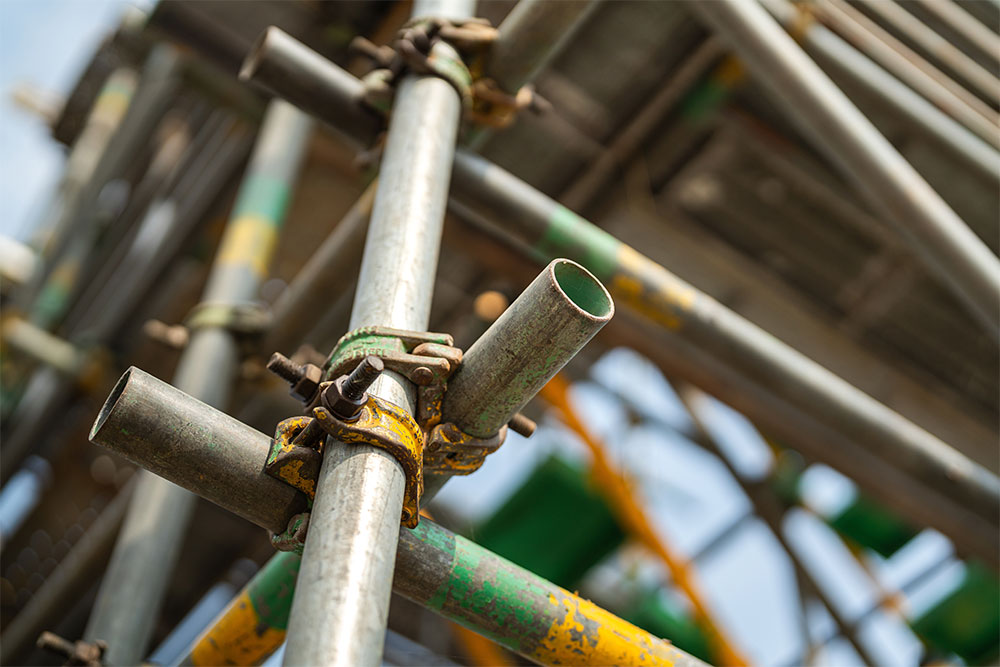Scaffolding Guildford: The Best Option for Your Building and Renovation Projects
Scaffolding Guildford: The Best Option for Your Building and Renovation Projects
Blog Article
A Comprehensive Guide to the Important Attributes of Scaffolding in Modern Building And Construction
The landscape of modern-day construction progressively relies upon efficient scaffolding systems that prioritize efficiency, advancement, and safety and security. As jobs expand in complexity, comprehending the necessary features of scaffolding ends up being vital for making sure worker safety and security and enhancing task timelines. This guide checks out different types of scaffolding, highlights crucial safety functions, and takes a look at product improvements that contribute to performance and sustainability. The implications of these aspects expand far beyond mere construction methods, motivating a better look at just how they influence total task success and employee wellness.
Kinds Of Scaffolding
Although scaffolding systems can differ extensively in design and application, they usually fall right into several distinct categories that satisfy different building needs - Scaffolding. The most common types include supported scaffolding, suspended scaffolding, and rolling scaffolding
Supported scaffolding is composed of platforms sustained by a structure of posts, which give a stable and raised working surface area. This kind is commonly made use of for tasks that require significant elevation, such as bricklaying or exterior paint.
Put on hold scaffolding, alternatively, is made use of for tasks requiring access to high elevations, such as cleansing or repairing building facades. This system hangs from a rooftop or one more framework, enabling employees to lower or increase the platform as needed.
Rolling scaffolding features wheels that enable simple flexibility across a job website. It is especially useful for tasks that call for regular relocation, such as indoor operate in huge spaces.
Each kind of scaffolding is designed with particular applications in mind, making sure that building and construction tasks can be carried out effectively and properly. Recognizing these categories is important for selecting the proper scaffolding system to fulfill both task needs and website conditions.
Key Safety And Security Functions
Safety and security is paramount in scaffolding systems, as the possible dangers related to operating at elevations can bring about serious accidents if not appropriately handled. Secret security functions are necessary to guarantee the well-being of employees and the stability of the building site.
Primarily, guardrails are critical. These obstacles offer a physical protect versus falls, dramatically lowering the threat of significant injuries. Additionally, toe boards are typically used to prevent tools and materials from diminishing the scaffold, protecting employees below.
An additional important element is making use of non-slip surfaces on systems. This feature enhances grasp, especially in negative weather, thus decreasing the possibility of drops and slides. Additionally, gain access to ladders need to be firmly positioned to facilitate risk-free entry and leave from the scaffold.
Regular assessments and maintenance of scaffolding systems are additionally essential. These examinations guarantee that all elements are in good problem and operating appropriately, dealing with any kind of wear or damage quickly.
Last but not least, proper training for all workers associated with scaffolding procedures is necessary to make sure that they understand safety and security procedures and can recognize prospective threats. Scaffolding. Collectively, these attributes produce a much safer working environment and substantially mitigate threats connected with scaffolding
Material Developments
Improvements in product scientific research have actually significantly affected the scaffolding industry, improving both safety and security and effectiveness in modern construction. The introduction of high-strength steel and aluminum alloys has actually changed traditional scaffolding systems.
Additionally, ingenious composite materials, such as fiberglass-reinforced plastics, have become viable choices. These products are resistant to rust and ecological deterioration, thus prolonging the lifespan of scaffolding systems, particularly in harsh weather. The usage of such products contributes to reduce upkeep costs and ensures consistent efficiency with time.


Style Factors To Consider
Taking into consideration the complexities of modern construction jobs, efficient scaffolding layout is vital to making sure both performance and safety and security. Design factors to consider should encompass numerous factors, consisting of load ability, elevation, and the specific needs of the construction website. Each job offers distinct difficulties, necessitating a flexible approach to scaffolding systems that can adapt to differing problems.
Structural stability is important; for that reason, engineers must calculate the loads that the scaffolding will sustain, consisting of workers, products, and devices. The option of materials plays a crucial role in making certain the scaffolding can withstand these lots while continuing to be lightweight and long lasting. Furthermore, the design has to permit service scaffold meaning simple accessibility and egress, promoting the smooth activity of employees and materials.
Safety attributes, such as guardrails and non-slip surfaces, ought to be incorporated to minimize dangers of crashes. The design must take into consideration the surrounding setting, including potential risks and nearby structures. By addressing these design factors to consider, building and construction companies can improve the effectiveness of scaffolding systems and promote a more secure working setting, eventually adding to the general success of the project.
Upkeep and Examinations
The performance of scaffolding systems extends beyond initial design and application; ongoing maintenance and normal assessments are essential to ensuring their proceeded performance and security throughout the period of a project. Normal inspections should be performed by qualified employees to recognize any indicators of wear, damage, or instability that can endanger the stability of the scaffolding.
Upkeep methods need to include regular checks of structural elements, such as installations, planks, and frameworks, guaranteeing that all elements stay secure and cost-free from corrosion or various other wear and tear. Furthermore, the performance of security features, such as guardrails and toe boards, must be evaluated to ensure compliance with safety guidelines.
Paperwork of all assessments and maintenance activities is essential for liability and governing compliance. An organized strategy to record-keeping not only help in tracking the problem of the scaffolding but additionally offers required proof in the occasion of an event.
Inevitably, establishing a thorough maintenance and assessment schedule will substantially decrease the danger of accidents and boost the total safety of the building website. By focusing on these practices, construction managers can safeguard employees and copyright the task's stability.

Verdict
To conclude, the important attributes of scaffolding in modern-day construction incorporate an array of important components, consisting of varied types, key security systems, material innovations, and thoughtful layout considerations. Stressing safety with guardrails and non-slip surface areas, alongside improvements in products like high-strength steel, enhances both efficiency and sustainability. Furthermore, routine maintenance and assessments are essential for making certain architectural honesty and safety and security on construction sites, inevitably helping with effective task implementation and promoting the well-being of check my blog workers.
The landscape of contemporary construction increasingly depends on efficient scaffolding systems that focus on effectiveness, technology, and safety and security.Innovations in material scientific research have actually substantially influenced the scaffolding market, enhancing both safety and efficiency in contemporary building and construction. On the whole, these material innovations not only enhance the performance and safety of scaffolding systems but also line up with the sector's press in the direction of sustainability, as lots of contemporary materials click here to read are made to be much more eco friendly.
Taking into consideration the intricacies of modern-day building and construction projects, efficient scaffolding design is extremely important to guaranteeing both capability and safety and security.In verdict, the crucial attributes of scaffolding in modern-day building encompass a variety of crucial elements, consisting of diverse kinds, essential security mechanisms, product developments, and thoughtful design considerations.
Report this page